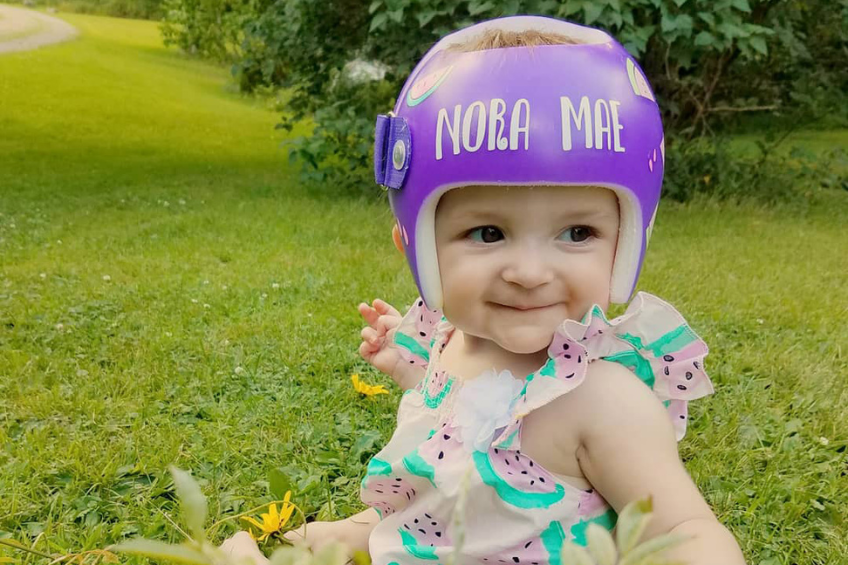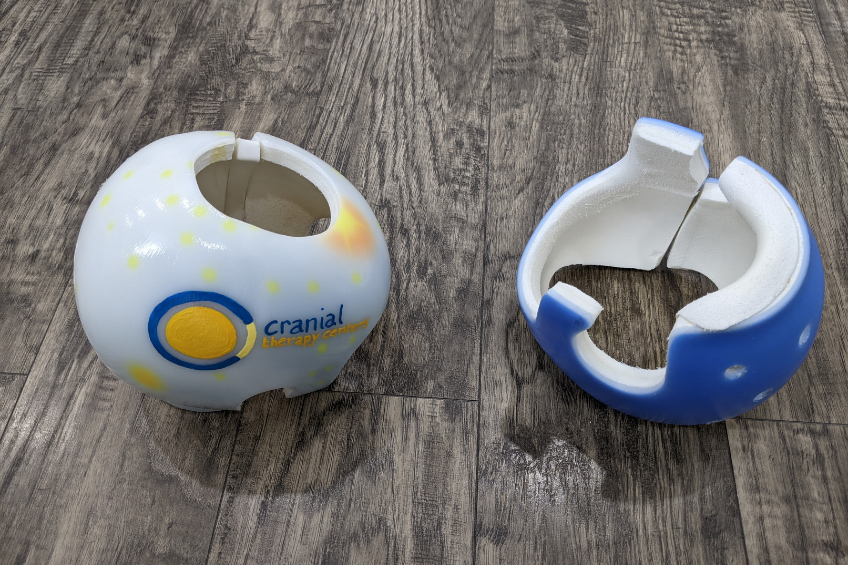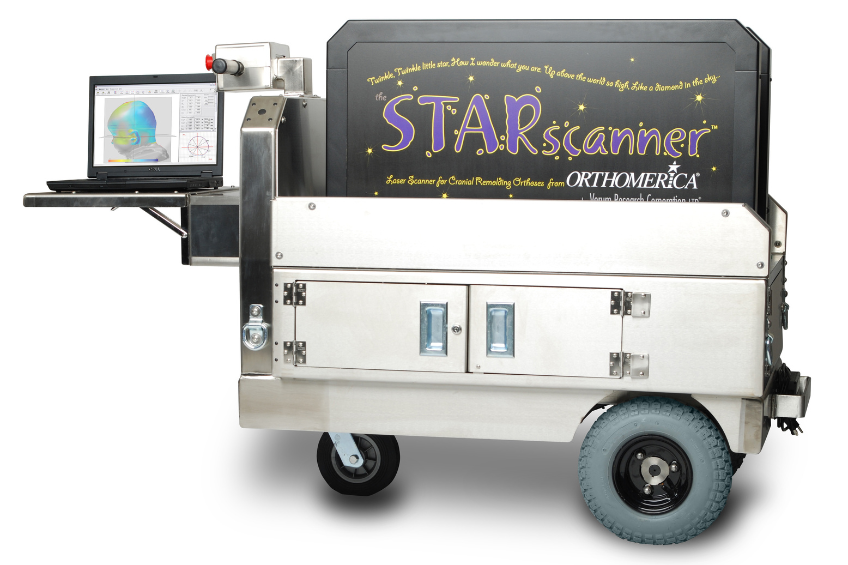Why is That Baby Wearing a Helmet?
/
For most of us, babies wearing decorative helmets have become more commonplace and a baby who is wearing a cranial helmet is not looked at in sorrow as who knows what horrible disease that poor infant has. However, there are still many other folks who don’t understand why a perfectly normal and healthy infant is wearing a strange contraption.

Helmets have been worn for many centuries usually for combat, horseback riding and more recently in the last hundred years or so for bikers, motorcyclists, fire fighters, hockey players and astronauts. Helmets are generally understood as protective gear for hazardous occupations and sports. In ancient times, people used horse and human skulls as helmets for various reasons, even burying their citizens in them.
From the first to the third millennia BC, Greek helmets made out of hammered bronze were worn by Babylonian, Assyrian and Sumerian warriors with a face mask version worn by the Corinthians. By the eighteenth-century helmets made from dried pith or wood were adopted by the English and other countries for sports and war. This led the way for lighter and more comfortable versions of helmets which ultimately led the United States Army Natick Research, Development and Engineering Center to develop the Personal Armor System Ground Troops helmets from 1970 to 1997 which coincided with the development of the baby cranial helmet.

Mothers in certain Asian cultures molded homemade pillows out of tightly rolled towels or fabric into large donuts to prevent flat heads. Other Chinese culture purposely shaped their babies’ heads into flat shapes and still other ancient cultures such as the Egyptians formed their infants’ heads to elongate them such as the famous Queen Nefertiti’s head.
In the 1990’s extreme sport enthusiasts began wearing helmets for skateboarding, skiing, and motorcycling after two well-known celebrities, Michael Kennedy and singer Sonny Bono died after skiing accidents. Many ski helmets are made with a plastic shell and an inner Styrofoam lining that come in a large range of colors and whimsical decals. At the same time baby cranial helmets became popular because of the “Back to Sleep campaign” of the 1990’s.
A mysterious killer of infants called sudden infant death syndrome (SIDS) was being investigated at that time since doctors and researchers could not find a definitive cause. Yes, some claimed it was due to an underdeveloped breathing condition in infants, some who were premature. Yet, there were premature infants who did not die of SIDS and full-term infants who did. This is where the directive to have babies sleep on their backs was born. Thankfully there was a great reduction in sudden infant death (statistics range from 40 to 50 percent) and most doctors not only advised but insisted that their newborn baby patients sleep exclusively on their backs. The consequence of this innovation caused and still precipitates the condition known as plagiocephaly or flat head syndrome.
For those parents who take the back to sleep instructions to the nth degree, there is a chance for their baby to develop a flat head. Some parents are more flexible and will only put their babies on their backs for long term sleeping at night and will keep them on their sides or even their tummy when the parents can look in on them. Regrettably, it only takes moments for an infant to suffocate and stop breathing even during daytime napping. Parents are advised to only put the infant on its stomach for what is now called, “tummy time” when the baby is awake. Tummy time causes the baby to exercise its neck muscles and encourages him or her to pick up their head as high as possible with parents or siblings coaching them with toys or other ways.

When a doctor or parent notices that the back or the side of the baby’s head is flat that is the time to bring the baby to a cranial therapy specialist to be evaluated usually by six months of age and ideally by three months when the bones are still soft and easy to reshape. If necessary, the baby will be fitted with a custom helmet made just for him or her. Helmets such as these will make the head rounder at a faster pace and prevent the child from growing up with an unsightly flat head.
The earlier that the helmet therapy is started the shorter the wearing of the helmet will be. Early infancy is when the skull and brain grow rapidly, and the bones are easily malleable. Although the diagnosis of plagiocephaly must be ultimately done by a professional there are methods that parents can utilize to check out their baby’s head. For example, looking from above the baby’s head you may see the flattening or when looking at the baby’s face you may see that both sides are not symmetrical.
Parents who are facing the challenge today of a cranial helmet for their baby, will be pleasantly surprised at how lightweight and airy today’s helmets are constructed. There is a hole on the top for air to get through and prevent itching and sweating as well as space for the ears to get air. If the baby’s head does get irritated and a rash develops the cranial center specialist will adjust the helmet accordingly. It is of utmost importance to go to a highly recommended, well trained, and experienced technician who will measure your child’s head accurately.
In 2001, the STARband helmet was introduced for babies experiencing flat head syndrome severe enough to require helmeting. Since this helmet can be adjusted as the baby’s head grows and changes, almost one hundred percent of the wearers will only require one helmet for complete treatment. The STARscanner™ is used to look at the infant’s head from all angles to determine how severe the plagiocephaly is. The scanner captures a 3-D image of the baby’s head, and the results are read by the cranial specialist.

There are still some doctors who are holdouts for the natural way to go which is to let the head round out on its own. This may work with some babies who are much more advanced for their age and will not allow the parents to keep him or her on their back but will turn to their stomachs by themselves. This is good and bad because unless the baby is capable of lifting their head high there is a danger of suffocation while sleeping on their stomach. This writer knows of an eleven-year-old girl whose parents were advised by their doctor to let nature take care of her flat head and guess what, this girl still has the same flat head that she had as an infant and it did not round out by itself. Factors such as keeping the baby in a car seat, car swing or crib for extended periods during the day are definitely factors that increase the likelihood of the flat head not improving. It’s pitiful that an infant who is well behaved and stays in this equipment for great parts of the day is the one who will end up with plagiocephaly. The crybabies that are held will less likely be the flat headed ones.
As of 2013, there were thirty -seven approved cranial orthotic helmets which standardized the treatment of plagiocephaly with such devices. As of today, although this writer does not have the exact statistics, there are many more devices approved by the FDA. We must remember that there is also a financial angle to this treatment and there are still some reluctant insurance companies that will not approve this therapy however, there are parents who will fight till they get approved and there are also some organizations that will supplement the cost of the regiment for parents who cannot pay fully. Never ever use another baby’s left-over helmet for your child. This is very dangerous and can cause scarring for life.
Final Words
Helmets were originally worn for protection only but now if you know that an infant wearing a helmet is not waiting for their dad to take them for a bike ride rather for most of their day during eating, playing, and sleeping their heads are being molded for a successful future helping them become successful and productive citizens.
Now that you have a better understanding about baby cranial helmets you will be more comfortable approaching the adorable baby of your friends or relatives. You will now be aware that the parent has already gone through any emotional turmoil in adjusting to the helmet, and they will be more than happy to discuss with you how their baby’s therapy is advancing especially if you are afraid that your own infant is having the same problem. As you can see, the baby is not experiencing any discomfort while wearing the helmet and neither will your baby.
Any responsible parent will be willing to set aside a few months of their lives to take upon themselves the awesome commitment of assuring that their child will have the best chance of leading a normal and productive life as a toddler, teen, and adult. All you have to do is take a peek at one adult or teen especially boys whose parents and doctors did not pick up on the plagiocephaly that was present when the person was an infant, to get you running to a cranial specialist to check out your baby’s flat head. Perhaps, it will not be as terrible as you think, namely that your infant will simply need physical therapy or worst-case scenario a helmet for a few months of their long life to be.

Cranial Therapy Centers is the only early interventions cranial center in the United States which provides both helmet and manual therapy treatment. We are American Board for Certification in Orthotics, Prosthetics and Pedorthics Facility. Visit us in Lakewood NJ, at 1352 River Ave Unit 14, Lakewood NJ, 08701 or in Teaneck NJ at 1086 Teaneck Road Suite 3F, Teaneck, NJ 07666. You can also email us info@cranialtherapycenters.com
